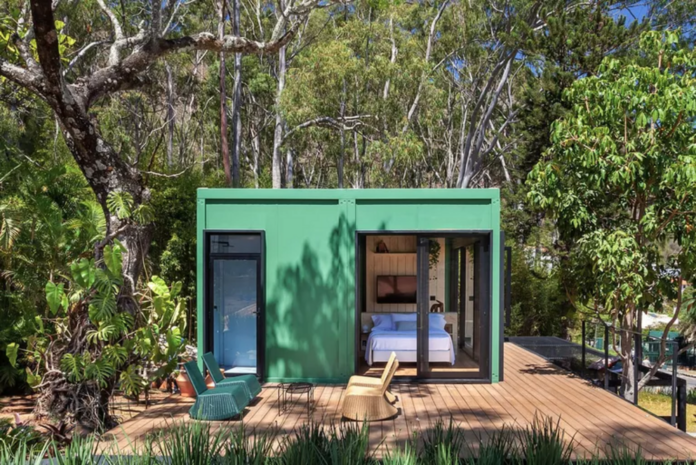Vibrant modular micro-dwelling made with shipping containers
It’s designed to be low-cost and easily relocated.
Over the years, we here at Treehugger have asked whether habitable buildings made out of recycled shipping containers make sense. Sometimes shipping container architecture does make sense, but it can present challenges in terms of potential structural issues or hooking them up to utilities, as well as the fact that shipping container interiors are built for cargo, not people. But that hasn’t stopped designers from exploring the possibilities. And when done right, shipping container architecture can indeed present some interesting housing solutions.
Over in Brazil, a local architecture studio, Plano Livre, created this rather intriguing modular prototype out of two connected shipping containers. Nicknamed Estúdio Lapinha, it was built initially for an exhibition, and it has since been dismantled and reassembled in Lapinha da Serra, a village in Minas Gerais state that is known for its beautiful waterfall landscapes. With its nature-themed materials and color palette, the studio explains that the 322-square-foot (30 square meter) prototype is meant to be a place to soak in one’s natural surroundings:
“The landscape is the protagonist. The space is built for contemplation. Wide glass doors dissolve the boundaries between exterior and interior. The tones bring nature into this refuge.”
Indeed, the dwelling is a bit different from the typical shipping container home, in that it has been built out of modular container units that are specially designed for the construction industry. Due to the supply chain issues brought on by the global COVID-19 pandemic, conventional shipping containers were in short supply in Brazil, so the architects decided to source their containers from a local construction company.
These construction industry containers differ in that they are designed to be easily assembled and disassembled, and are fabricated using higher quality and more durable materials, in addition to being insulated with expanded polystyrene coating on the wall panels. The roof apparently also is designed in a way so that water drains off easily.
With these purpose-made containers in hand, the architects proceeded to connect the pair by opening up the interior to create a generous open floor plan that encompasses a flexible living area for sitting and sleeping, as well as a kitchen and bathroom.
As the architects explain, they aimed for a cost-effective, yet aesthetically pleasing design overall:
“The construction process guided the project. Two container modules were attached laterally, their industrialized components exposed without camouflage. The hydraulics are concentrated in one wall, creating the infrastructural module. This strategy, apart from reducing costs, frees the rest of the space. Therefore, the other container is a flexible, indeterminate module, a free plan, which, in this edition, receives Estúdio Lapinha’s furniture.”1
Many of the furnishings like the couch and storage unit were custom-made with durable, marine-grade plywood, which was then sealed to maintain the wood’s natural beauty.
Much of the storage consists of open shelving made with black-painted metal rods, which lend a modern look, besides allowing the occupant to display their belongings for easy access.
The color scheme implemented reveals a kind of color-coding to help differentiate the various spaces inside. Earthy, terracotta-like oranges tint the kitchen area, while the vibrant green of the main living spaces echoes the colors of the exterior. All in all, the colors help the structure blend into its natural environment, giving the otherwise boxy form a sense of groundedness.
The blue-toned bathroom is well-designed, as it has been divided up into three zones so that it can be used by more than one person at a time if needed. For instance, the toilet is sectioned off in its own room, while the sink occupies the central zone, allowing users to wash their hands easily. The shower is in its own room off to the side, and also connects to the exterior deck via another glazed side door.
Much of the spacious feeling of the project can be attributed to its use of large glass doors that can open up wide to welcome the exterior in, and the inclusion of a wooden deck and another outdoor lounge area with two nets.
According to the design team, there was little to no waste from the relocation and reassembly process. The idea here was to create a prototype that is modular, low-cost, and able to respond to a variety of sites, say the architects:
“In addition to being a single physical space, the project embraces the idea of generating a system. For this reason, Estúdio Lapinha is a prototype that can be expanded, replicated, and implanted in other contexts. Different arrangements of containers create different spaces for different experiences to be lived there.”1
To see more, visit Plano Livre and their Instagram.
Fact checked by Katherine Martinko
For full references please use source link below.

